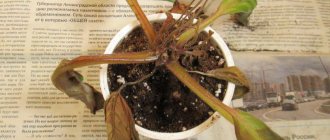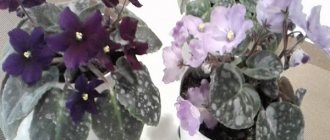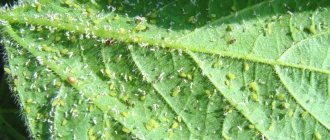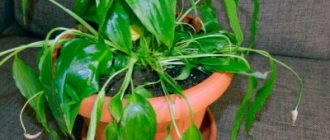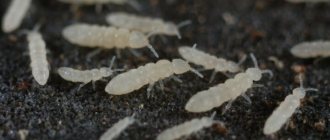Violet is an indoor plant, and therefore is attacked by pests much less often than those that grow in open ground. But there are still quite a lot of people who like to enjoy the nutritious juices of this beauty. The peak of parasite activity occurs at the end of spring (May) and beginning of autumn (September). It is during these months that pests of violets appear most often. They enter houses and apartments through slightly open vents and windows, on clothes, brought in fresh fruits and vegetables, as well as on new plants.
Pests are capable of multiplying very quickly, and therefore in a short time they can cause irreparable damage to a delicate violet.
How to reduce the risk of parasites on violets
Be sure to keep the violet purchased (or acquired in another way) in “quarantine” for two to three weeks. If you have any suspicions about its condition, treat the plant with Fitoverm and water the substrate with Fitosporin-M once a week for a month to prevent diseases.
If you use ready-made soil for planting and replanting Saintpaulias, be sure to sterilize it first, since soil from greenhouses, greenhouses and flower beds can sometimes be contaminated. Conduct your own soil collection away from the city, somewhere in the forest. Wash and sterilize old pots well.
Do not allow a sharp decrease or increase in the temperature; the room air is too dry - moisten, do not overdry the substrate and do not flood it. Provide Saintpaulia with bright but diffused light in sufficient quantities for growth and flowering. Otherwise, your Saintpaulia will be weakened and vulnerable to parasites. Read more about the rules for caring for violets here. Small pests cause the greatest harm to violets. In this article we will talk about each insect and how to deal with it in detail.
Treatment and prevention measures
To understand how to treat violets against pests, you first need to diagnose their type . After this, it is necessary to treat the plant with a special preparation suitable for the specific type of pest.
Most often it is necessary to do 2-3 applications at intervals of several weeks and then replace the soil.
To combat some pests, it is enough to dry the soil, but for some, unfortunately, it is not possible to remove them.
In any case, in order to prevent pests from appearing on your plants in the future, you must adhere to preventive measures .
ADVICE! To prevent the appearance of insects, first of all, it is necessary to carefully treat all new plants and place them in quarantine for 2-3 weeks.
When replanting, you should use thoroughly washed and sterilized pots and sterilized soil.
Nematodes
The most dangerous insects for violets are nematodes - tiny worms. They usually affect Saintpaulias weakened by disease or improper care. Nematodes settle in the soil on the roots. They often penetrate into the roots and into the vessels that feed the rosette, after which they suck out the juices from them. As a result of their vital activity, toxic substances are produced. In places of damage, swellings and thickenings (galls) form on the roots. The process of the flower’s absorption of nutrients from the soil is disrupted.
It is almost impossible to detect the pest in its early stages. Only when transplanting violets, during inspection of the roots, can the lesion be determined. When there is a large accumulation of nematodes, light green spots appear on the leaves, which darken and dry over time. Thickenings appear on the stem. The growing point of the violet also begins to dry out, and new leaves appear deformed.
Violets affected by nematodes are stunted in growth, weaken, and do not form buds. Their stem gradually becomes bent. It is almost impossible to remove nematodes. The violet will die sooner or later. But nematodes can also move into neighboring pots, so the plant affected by parasites should be destroyed along with the soil, and the pot, tray and flowerpot, if used, should be thoroughly disinfected.
To prevent infection with nematodes, we recommend purchasing substrate for your indoor violets only in specialized stores. Be sure to heat the soil you prepare yourself in the oven or disinfect it in any other way, for example, steam it or freeze it in the freezer.
Ticks
In a dry, hot room, various types of mites are frequent guests of indoor violets. Below are the signs of a tick and photos of different types.
Red spider mite
- So, you will detect the appearance of a red spider mite by red dots and thin cobwebs on the leaves of the plant. The leaves curl and fall off.
Spider mite
- You can recognize a common spider mite by its heavily cobwebbed leaves with brown indentations on the surface. As a result of its vital activity, violet leaves become brittle, darken and fall off.
Cyclamen mite is visible only under a microscope
- Cyclamen mites like to settle on young leaves in the center of the rosette. They suck the juice from the leaves, causing them to become deformed and covered with yellow spots. The flower stops growing, the stem bends and becomes shorter, the leaves curl and die, the buds become deformed and do not open.
This may be interesting: Oxalis (Oxalis) - caring for family happiness at home
If parasites are detected, we advise you to take the flower pot to the bathroom and try to wash off the insects under the shower. However, it will not be possible to cope with all individuals and their larvae using this method alone. For a complete guarantee, you will have to treat the violet with chemicals - insecticides. There are universal remedies for a complex of pests - “Fitoverm” or “Aktellik”. Treatment involves spraying the leaves and watering the soil two to three times at weekly intervals (read the attached instructions).
Main pests of violets
Mealybug
Mealybugs are scale insects 3-6 mm in size, covered with white fluff . Visible to the naked eye in leaf axils, in young buds and on young leaves.
Mealybug.
Damaged surfaces leave behind a white coating resembling cotton wool.
Both adults and larvae are dangerous.
More detailed information about mealybugs with photos and the fight against them is discussed here.
Thrips
Adult thrips are dark-colored flying insects 1-1.5 mm in size ; the larvae are small yellow.
They damage the leaves , leaving white stripes , as well as the buds , leaving a scattering of pollen; the flower blooms with damaged anthers.
Thrips.
Brown or black spots appear on the leaves and flowers of the plant.
More information about the fight against thrips is written here.
Ticks
Ticks are microscopic in size and impossible to see with the naked eye . Violets are usually affected by the following types of mites:
- arachnoid;
- cyclamen;
- flatfish.
Mite on a violet.
Ticks feed on violet juice , as a result of which the foliage curls, droops, practically stops growing, and has a dusty appearance. The growing point takes on a grayish tint. The buds become deformed and do not open.
More details about ticks with photographs and their treatment are written in this article.
Aphid
Aphids primarily harm flowering plants . These small green insects are visible to the naked eye and form colonies in buds or on the inner surface of leaves.
Aphid.
Aphids feed on plant sap . After an aphid attack, the leaves become deformed and wither. White sticky aphid secretions appear on the plant.
You will learn more information about aphids with photos and how to treat violets from this insect in this article.
Midges
Midges and mosquitoes (sciarids) are insects that, as a rule, do not harm Saintpaulia.
The danger is posed by larvae , which destroy the soil, making it more dense and making it difficult for air to penetrate, resulting in damage to the root system.
Sciarid fly.
If the population of adults grows, they will begin to feed on violet leaves and petioles.
You will learn what to do if violets are infested with midges from the video at the end of our article.
Nematodes
Nematodes are 2 mm worms that live in the soil . Nematodes damage plant roots , sucking juices from them and at the same time releasing harmful substances. In places of damage, harmful formations (galls) are formed.
Nematode.
To detect the parasite, you need to remove the plant from the pot and examine the root system.
Woodlice
Woodlice are small land crustaceans that resemble small white armadillos in appearance. They quickly increase their population, while feeding on the roots and leaves of Saintpaulia.
Woodlouse.
They pose a particular danger to children and starters . Woodlice are nocturnal, which is when they can be seen with the naked eye.
Shchitovka
Scale insects and false scale insects are similar in appearance, similar to a small shield . To distinguish them, you need to try to remove them from the plant, in which case the shield of the scale insect will come off, and the false scale insect will come off along with the shield.
Shield.
Both adults and larvae cause harm by feeding on violet juice and secreting a sticky liquid. They live on leaves or petioles.
Springtails and springtails
Springtails and springtails live on the surface of the ground and, in principle, do not harm violets.
Their size is 2-4 mm, the color is white, cream, sometimes greenish. In the back of their body they have a growth that looks like a small fork, and it is with its help that they jump.
Springtails.
During mass dispersal, young roots of Saintpaulia can be damaged.
Sciarides
In an over-moistened and rotted substrate, flies and mosquitoes - sciarids - can appear. Adults are almost safe for violets, but their larvae quickly destroy and compact the substrate, reduce the access of oxygen to the roots, which causes enormous harm to the violet’s root system. However, if there are a huge number of midges, they begin to eat the leaves and stems of homemade violets. Sciarides pose a particular danger to young, not yet mature violets. Their vital activity leads to rotting of the stem and root system of the flower.
To get rid of them, you need to treat the soil with a solution of Aktara or Karbofos (water it). Additionally, you can coat the edges of the pot with chalk to prevent cockroaches. Adults are destroyed by any aerosols such as “Dichlorvos” or “Raid”. If the substrate is heavily infested with midges, it should be replaced completely. New primer should be calcined for 30 minutes in the oven to guarantee. The pot should also be disinfected. In the future, avoid waterlogging the soil.
Aphid
Aphids may appear on the back of young leaves of indoor violets. She can fly to you from the neighboring balcony through the window, or you yourself can bring her into the apartment with flowers bought in a store or cut at the dacha. In addition to Saintpaulia leaves, it affects peduncles, buds and flowers. These small green (gray or black) insects feed on the sap of the plant. As a result, the growth of the flower slows down, the leaves fade, and the flower petals become deformed and dry out. When the aphid colony is numerous, it forms a white layer of sticky liquid on the surface of the leaves.
To fight aphids on violets, purchase one of the insecticides in the store: Fitoverm, Actellik, Mospilan, Actofit. Carry out the treatment strictly according to the instructions and in the quantity indicated on the packaging. Once is usually not enough to get rid of prolific insects.
Folk remedies
There are folk remedies to combat aphids on violets. One way is this:
- use onion peel - 50 g;
- add chopped garlic - 1 tsp;
- cut tomato leaves - 50 g;
- make an infusion in 500 g of water;
- Treat the flowers three times with the resulting infusion every 8 days.
If violets are severely infested with aphids, the flower is completely immersed in a freshly prepared infusion.
Other flowers help fight microscopic insects. So, if you place pelargonium next to a violet, its smell will drive away harmful insects in just a couple of days.
Thrips
Thrips on violets also like to feed on sap. These are small flying “insects” of a dark brown color. They have a wide range of attacks on indoor plants, including eating foliage. Thrips carry causative agents of various violet diseases from outlet to outlet, so they are very dangerous for indoor crowded plantings. You will see their presence by white stripes, brown or black spots on gnawed leaves and flowers. You can try to collect thrips by hand, but it is better to treat the flower with preparations such as Fitoverm, Actellik or Aktara. It is necessary to process not only the violet leaves, but also the substrate. Pick off flower stalks - Saintpaulia pollen is a favorite food of thrips.
This may be interesting: Beloperone (Justice) - Introduction to the flower, types and varieties
Mealybug
If your violet begins to become deformed and becomes covered with red-brown spots, and a white coating appears on its leaves, stems and petioles where they connect with the stem, most likely the violet has been attacked by another dangerous pest - the mealybug. It damages the folds of leaves and young flower stalks. It usually appears from other infected plants that you brought from the store or from a walk in the open air. In addition to appearance, infection with this parasite is easily recognized by the smell of the substrate - it emits an unpleasant mushroom aroma. Upon closer examination, you can see the worms themselves, which look like white fluff.
The affected violet quickly fades. Its leaves become dull and yellowish. Remove wilted parts of the plant. Treat the plant against mealybugs with one of the preparations: Aktara, Actellik or Fitoverm. It is better if you replant Saintpaulia into new soil, having first removed the remnants of the old substrate from the roots.
Treatment with celandine
You can use a plant such as celandine. The way to use it is as follows:
- Flowering celandine is collected in the amount of 300 g raw or 100 g dry;
- pour a liter of water over the grass;
- leave for 36 hours, you can boil for half an hour;
- Spray the affected leaves with the resulting solution.
Celandine in the form of a tincture or decoction helps against aphids
Woodlice
With high humidity in the room and frequent waterlogging of the substrate, woodlice settle in pots with violets. Woodlice are tiny white land-dwelling crustacean insects. They look like small armadillos. In moist and loose soil they multiply quickly and damage the roots and leaves of violets. Their presence is especially dangerous for still young, immature plants. In old houses and basements, where dampness prevails, woodlice can still be found today. Perhaps some individuals have made their way into your home.
Drugs - acaricides, of which there are a large number in special stores, will help destroy woodlice from violets. Purchase the appropriate preparation and carry out the treatment (spraying the plant and watering the substrate) in accordance with the instructions.
Pest prevention
Preventive measures against ticks are more effective than controlling these pests. Following simple rules for keeping violets will help them stay strong, healthy and delight with their beauty. The following rules must be adhered to:
- a new, just purchased flower should be placed separately from others, in quarantine,
- remove fallen flowers, rotten and yellowing leaves,
- create optimal conditions for life and flowering (appropriate light and temperature conditions, timely irrigation, fertilization), be sure to bathe the flower in hot and dry weather,
- do not place pots of violets very close to each other,
- There is no need to bring cut flowers into bouquets or grow roses into the room with Saintpaulias, because they are more likely to harbor parasites.
The number of pests increases at lightning speed if environmental conditions become hot and dry. Then it is better to bathe the violets in warm running water. By adhering to optimal climatic indicators (air temperature from 22 to 18 degrees and normal humidity), the activity of ticks decreases and they stop reproducing.
Ticks pose a great danger to Saintpaulias, so you need to immediately take measures to destroy them as soon as you suspect that plants have been infected by them. Timely treatment against these parasites will preserve the health and life of these delicate, beautiful flowers.
It is also useful to read: Treatment of the area from ticks
Podura (springtails)
Sometimes, on the surface of a damp substrate in a pot with a violet, springtails or podura settle. When the owner sees this insect for the first time, he literally freezes with horror - after all, tiny white or cream-colored insects with antennae are crawling in the pot under the flower. There are specimens painted in a greenish or silvery tint. The average size of a podura is approximately 2 mm, but there are also large specimens, up to 1 cm in length. Some of them crawl, others also jump with the help of a special fork attached to the underside of the abdomen. By the way, this feature (jumping) distinguishes springtails from the larvae of other insects - mealybugs, fungus gnats and thrips.
In fact, poduras in small quantities are not dangerous for indoor plants, including violets. They are part of the natural soil fauna. Poduras settle on the surface of the ground, love dampness and readily reproduce in it. Poduras feed on plant particles that begin to rot. We recommend immediately reducing watering the plant. Indeed, during overflow, when water stagnates on the surface of the substrate, forming silt, “uninvited guests” form a mass population and become a problem for both the flower and its owner. Particularly large specimens of springtails can damage young Saintpaulia seedlings, and at low room temperatures, minor damage can cause various infections.
This may be interesting: Camellia in an apartment - growing and care
To remove the fungus, you should sharply reduce watering of the plant. Pay attention to the composition of the substrate - it should not contain components that cause the development of fungi and mold: sawdust, tea leaves, dry leaves. Deprived of their usual comfortable habitat, springtails will disappear on their own and will stop bothering your violets.
Another folk method against fools. Place the pot with the flower in a basin and fill it with settled warm water “over the top”. When the springtails float to the surface of the water, you will collect them with something like a strainer.
Regular raw potatoes, cut in half, will help to collect springtails. Place both halves cut side down on the surface of the substrate for several hours. All the springtails will gather on the potato cuts. All you have to do is carefully lift the halves from the ground, holding them with a flat spatula from below, in order to collect all the individuals and destroy them. This procedure will have to be carried out several more times until you are sure that you have gotten rid of all the individuals.
If the colony of springtails has become too numerous, we recommend treating the plant with insecticides. The drug Bazudin is suitable. It is scattered over the surface of the substrate in a thin layer. The fools will probably die within a few hours. The drug Pochin will cause a similar effect. Only its granules should be mixed with the soil. It will begin to act immediately, and in a few hours all insects will be destroyed. You can also treat the soil with a solution of Mospilan, Aktara, Pyrethrum according to the instructions. But the main thing is to dry the soil optimally.
Proper care of violets
Flower growers try to adhere to certain rules . For example, in order for a flower to feel at home and develop well, it is necessary to provide conditions as close as possible to the place of growing season. Saintpaulias are native to the tropics of East Africa with a humid and warm climate. If the water, temperature, light or air conditions are violated, the flower weakens, and its resistance to the effects of various microorganisms deteriorates.
Violets love warmth, so they need to be kept in a room at a temperature of 20-25 degrees without drafts or fluctuations. If flowers are placed in a cold room, they will simply stop growing. Storing this plant at too low temperatures with frequent watering can lead to rotting of not only the stem, but also the roots. Temperatures above 30 degrees also have a negative effect on violets, causing bacterial and fungal infections.
Saintpaulia prefers daylight, in other words, soft and diffused light , but not too bright. With a lack of light, the flower stops blooming, and with too much light, the leaves lose their elasticity, become spotted and turn yellow.
The health of this attractive flower also depends on the soil, because infection with diseases and pests most often occurs through it. The soil in the pot should be nutritious, loose, light, allow excess water to drain out and allow air to pass through well. Violet has a very fragile root system, which in heavy soils based on garden soil is susceptible to rotting and waterlogging. To avoid this, it is necessary to freeze the soil for a week before planting the flower.
Saintpaulia likes it better when the soil is not wet, but moist , since the plant is a representative of the tropics. The violet should not be watered or sprayed with ice water. To obtain the required air humidity, flower pots are placed in trays moistened with gravel, expanded clay and sphagnum, or micro-spraying is performed.
When the soil in a pot with a flower is acidic, that is, has a pH below 5, the leaves begin to acquire a yellow tint at the edges, phosphates stop dissolving, and the rosette thickens. In such a situation, it is better to use a dolomite solution to water the violet, consisting of one spoon of flour and five liters of water. In alkaline soil, the indoor plant stops growing and turns pale. In this case, it is advisable to water it with a mixture obtained from 2.5 liters of water and a tablespoon of vinegar.
Scale insects and false scale insects
Sometimes on violet leaves you can find sticky discharge and tubercles from hidden parasites. These are scale insects or false scale insects (coccids). They are located on violet rosettes, on its leaves or petioles. The insects reach seven mm in length and look like brown scutes. In scale insects they are flat, while in false scale insects they are pea-shaped. Great harm is done to the plant. At the site of the parasite's suction, a yellow spot appears on the leaf, which grows in size as the juice is sucked out. Then the leaf turns completely yellow, curls and falls off. If there are a lot of parasites, the violet will stop growing, the leaves will dry out, and it will die.
If you find at least one adult violet on an indoor violet, we advise you to treat the flower and all nearby rosettes as soon as possible. Scale insects carry many young ones under their shells, which easily move and disperse. Scale insects can be removed from the plant manually - with tweezers, a toothbrush or a napkin moistened with alcohol (vodka). Then the plant should be treated with a suitable preparation (Aktellik, Agravertin, Aktara). Avoid crowding of plants, adjust watering and lighting



